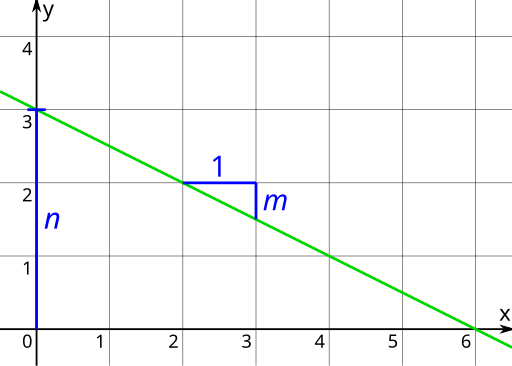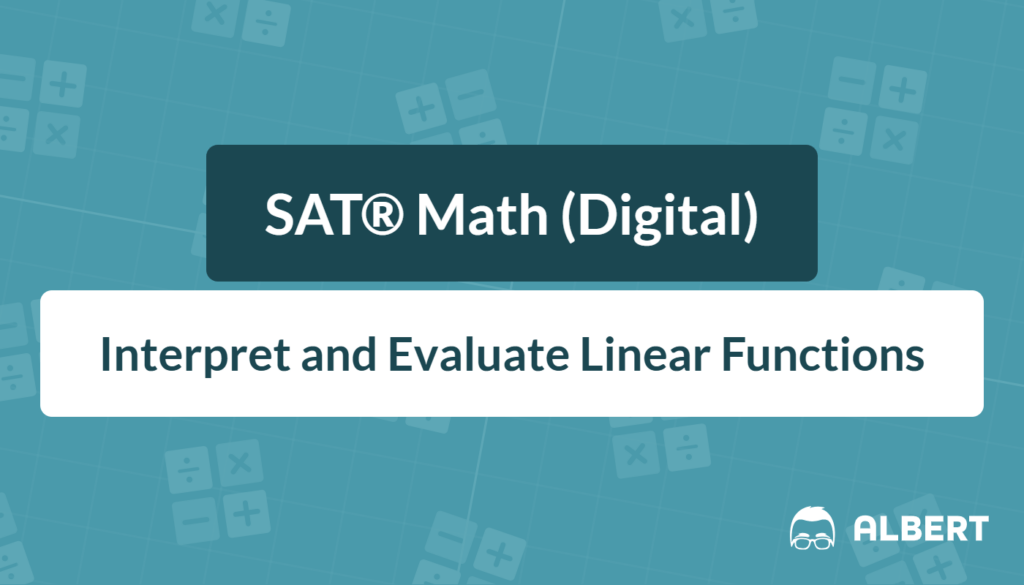What We Review
Introduction
Linear functions show up everywhere on the SAT®. Therefore, being able to interpret and evaluate linear functions quickly is a high-value skill. Whether the test gives a story, a table, or a graph, the College Board expects students to switch forms, spot key numbers, and solve in seconds. The following guide breaks the topic into bite-sized pieces, offers step-by-step examples for evaluating linear functions, and finishes with practice questions—perfect for quick review the night before an exam.
Quick Recap: What Is a Linear Function?
- A linear function is a rule that produces a straight-line graph.
- It has a constant rate of change called the slope.
- Two common equations appear:
- Slope-intercept form f(x) = mx + b
- Standard form Ax + By = C

Think of a car’s cruise control. When speed stays at 55 mph, distance increases by 55 miles every hour, and the graph of distance vs. time is a straight line.
Building a Linear Model from Context
Creating an equation from words may look long, yet the steps repeat every time.
The Process
Step 1: Identify the variables
Decide which quantity is input (x) and which is output (f(x)).
Step 2: Find the Rate of Change (Slope)
How much does the output rise or fall when the input increases by one?
Step 3: Locate an Initial Value (y-Intercept)
This is the output when the input equals zero.
Step 4: Write the Function
Combine slope (m) and intercept (b) in f(x) = mx + b.
Example: Earning Money at a Part-Time Job
A student earns \$12 per hour plus \$30 in tips per shift. How much will the student earn in 40 hours?
Step 1: Variables
- Input x = hours worked
- Output f(x) = total dollars earned
Step 2: Rate of change
Slope m = 12, representing the dollars per hour
Step 3: Initial value
When x = 0, tips give \$30 → b = 30
Step 4: Function
f(x) = 12x + 30Step 5: Determine the pay
f(40)=12(40)+30=480+30=510She will earn \$510.
Interpreting Pieces of a Linear Function
What the Slope Tells Us
- Positive slope → output rises as input rises.
- Negative slope → output falls.
- Units: “output units per input unit.”
Meaning of the y-Intercept
The situation’s starting point when x = 0.
Interpreting Specific Pairs
Point (8, 70) means “When the input is 8, the output is 70.” Always include units.
Seeing Structure
Factoring or rearranging may reveal common factors or hidden slopes.
Example 2: Temperature Drop Over Time
The temperature T (in °C) in a freezer follows T(h) = -3h + 20, where h is time in hours. Determine the temperature after 2 hours.
Substitute h=2.
T(2)=-3(2)+20=-6+20=14Thus, the temperature will be 14^\circ C.
Evaluating Linear Functions Efficiently
Substituting
Substitute x into the function.
Mental Math Tricks
- If m or b is a multiple of 5 or 10, estimate quickly.
- Use distributive shortcuts: 7(50) = 7(5\cdot 10) = 35\cdot 10 = 350.
Reverse Evaluation
Sometimes the SAT® gives f(x) and asks for x. Solve the equation for x.
Example: Taxi Fare
A taxi charges according to C(m) = 2.5m + 4, where m is miles and C(m) is cost in dollars.
1. What is the cost for 6 miles?
Substitute 6 for m. C = 2.5(6) + 4 = 19.
2. What is the distance for a \$16 ride?
Substitute 16 for C(m) and solve.
| Step | Reason |
|---|---|
| C(m) = 2.5m + 4 | Original equation |
| 16 = 2.5m + 4 | Substitute C(m)=16 |
| 12 = 2.5m | Subtract 4 from both sides |
| m = 4.8 | Divide both sides by 2.5 |
The distance is 4.8 miles.
Switching Between Representations
Verbal ↔ Table
Read sentences to fill a table of sample points.
Table ↔ Graph
Plot table points, then connect with a straight line.
Graph ↔ Equation
From a graph, pick two clear points, find the slope, and then the intercept.
Effect of Equation Changes
- Increasing m → line gets steeper.
- Increasing b → whole line shifts up.
Writing Linear Rules from Limited Info
Two Points
- Find slope with m = \dfrac{y_2 - y_1}{x_2 - x_1}.
- Insert m and one point into y - y_1 = m(x - x_1) then simplify.
One Point + Slope
Already have m, so substitute directly.
SAT® Shortcut
If one point is the y-intercept, substitute b immediately and save time.
Example: Cell Phone Data Plan
When traveling internationally, a phone plan costs \$20 plus \$8 per GB. Another plan costs \$32 for 2 GB and \$48 for 4 GB. Write both rules.
For the first plan, there is a flat fee of \$20 plus \$8 per gigabyte. This gives a slope of 8 and a y-intercept of 20, resulting in the function:
C_1(g) = 8g + 20,
…where g is the number of gigabytes used and C_1(g) is the total cost for the first plan.
For the second plan, we are given two data points: (2, 32) and (4, 48).
First, calculate the slope:
m = \dfrac{48 - 32}{4 - 2} = \dfrac{16}{2} = 8
Using point-slope form with point (2, 32):
y - 32 = 8(x - 2)
Simplifying: y = 8x + 16
So the function rule for the second plan is:
C_2(d) = 8d + 16,
…where d is the number of gigabytes used and C_2(d) is the total cost for the second plan.
Common Pitfalls & How to Avoid Them
- Mixing up a negative slope sign—always double-check units.
- Misreading units themselves—hours vs. minutes changes the slope value.
- Forgetting consistent variables—do not switch time variable names mid-problem.
Quick Reference Vocabulary Chart
| Term | Simple Definition | SAT® Tip |
| Linear Function | A rule whose graph is a straight line, written in function notation | Look for constant change in tables |
| Slope (m) | Change in y per 1 change in x | Include units: “dollars per hour” |
| y-Intercept (b) | y-value when x = 0 | Often hidden in word problems |
| Input (x) | Independent variable | Usually time or number bought |
| Output (y) | Dependent variable | Cost, distance, temperature, etc. |
| Rate of Change | Another name for slope | Can be positive or negative |
| Standard Form | Equation Ax + By = C | Good for intercepts |
Practice Questions
1. A line passes through (3, -2) and (7, 10). Write its function in slope-intercept form.
2. For f(x) = -5x + 40, find x when f(x) = 0.
3. A gym charges \$25 sign-up plus \$15 per month. After how many months will the total cost reach \$130?
Answers
- y = 3x - 11
- x = 8
- 7 months
Final Takeaways & Next Steps
Interpreting and evaluating linear functions means more than crunching numbers. Therefore, remember to:
- Spot slope and intercept quickly.
- Translate among words, tables, graphs, and equations.
- Reverse the process if the SAT® gives outputs first.
Next, time individual practice sets to build speed. Good luck turning every line into easy points!
Sharpen Your Skills for SAT® Math (Digital)
Are you preparing for the SAT® Math (Digital) test? We’ve got you covered! Try our review articles designed to help you confidently tackle real-world SAT® Math (Digital) problems. You’ll find everything you need to succeed, from quick tips to detailed strategies. Start exploring now!
Need help preparing for your SAT® Math (Digital) exam?
Albert has hundreds of SAT® Math (Digital) practice questions, free response, and full-length practice tests to try out.









